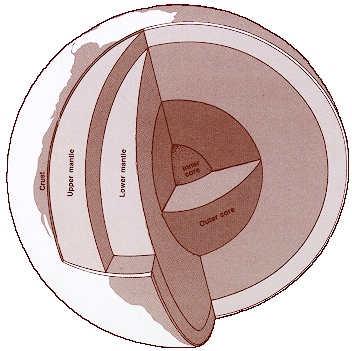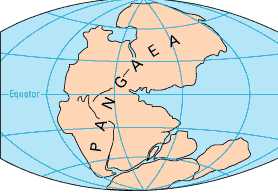The Earth Passes Gas
During the next 1.3 billion
years, known as the Archean Eon (28.26 yards long on the "100 Yard
Model"), the Earth separated itself into layers while it
was still liquified. Denser material settled toward the center
of the planet and lighter material rose towards the surface. This
has resulted in the Earth having four major layers, as shown in the
diagram on the right.
During this time, the various
gases that would make our early atmosphere and oceans were mixed into
this molten mess. These gases now had the opportunity to bubble
up and pass through the liquid rock to escape to the surface.
Once the gases passed through, they were kept from floating off
into space by Earth's gravity. Today, our atmosphere, our oceans and the crust are recycled and renewed through
volcanic activity, both on land and under the oceans. This helps
keep our atmosphere from getting 'stale'.
After a time the Earth's
exterior began to cool and form a hard crust. However, due to the
convection (warmer materials rising and cooler materials sinking in a circular motion) of the earth's interior, the crust cracked into many
pieces known as tectonic plates. These plates are like
giant puzzle pieces of the Earth's crust. The convection also
moves the plates around as the top of the convecting molten rock - with a consistency of thick, sticky taffy - 'grabs' onto the underside of the plates and puls them along in whatever direction that particular bit of convection is going. As tectonic plates collide, several things can
happen:
1 One plate
can slide under another and dive back into the mantle, melt and be
recycled in a future volcanic event, a process known as subduction. Subduction occurs, among other places, as the edges of the Pacific plate go under all of the continental plates surrounding the Pacific creating what geologists call the 'Ring of Fire'. Mount Saint Helens in the Cascade Range of Washington State is part of this 'Ring of Fire'; or
2 Both plates
can push into each other causing mountain
chains to rise along their colliding boundaries, which is how the ancient Appalachian Mountains were formed (and today's Himalayas are continuing to be built); or
3 Plates can diverge, or move apart from each other, creating a gap where magma (liquid rock in, or below, the crust) rises up to form volcanoes. This process is occuring at the Mid-Atlantic Ridge on the seafloor of the Atlantic Ocean; or
4 Plates can slide past each other in what is called a 'Strike-Slip Fault' which is occuring along the San Andreas Fault in California.
Separation Anxiety
As two plates move away from
each other they open up a gap known as a rift. This rift allows
molten magma to seep up from the mantle to fill in the gap. The
Mid Atlantic Ridge is a well known example of a rift zone
|
|
| Like Shrek, The Earth Has Layers |
|

Image
Credit: USGS
|
| Plate
Tectonics |
|

The theory of plate tectonics was first developed by the German
scientist, Alfred Wegener. He saw the continents on each side of
the Atlantic Ocean as giant puzzle pieces. He figured (correctly)
that they must have been joined together at one time and somehow
drifted apart. More on
plate tectonics.
Image Credit: USGS
|
Next Page
|